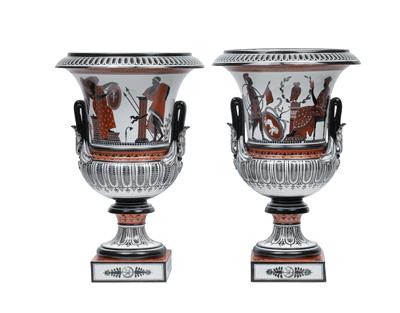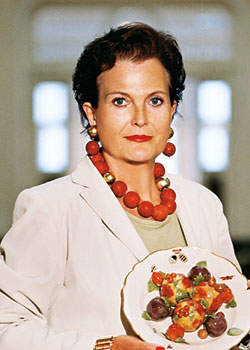A pair of Russian vases with ‘Etruscan images’,

porcelain, in the form of a Krater, body with black and white rims, white arched borders, black-painted foliate friezes and palmettes on reddish brown ground, encompassed by paintings in black and reddish brown on a white ground, 1. vase depicting a warrior, shield with a lion, owl on a column flanked by laurel branches and a lady worshipping at a sacrificial site with fire, basket of fruit and dog, those making a sacrifice offer fruit, 2. vase with seated genius painting a torch onto a shield, warrior and column with arrows and a seated lady with an arrow, before a column with a swan, and a standing lady with a vessel and torch in her hands, black branches of palmettes and flowers with bows on a white ground, square plinth with rosettes flanked by black palmettes on a white ground, black raised handles with black accented acanthus leaf terminals, height 39.5 cm, Ø 27 cm, some restoration, hairline crack to the owl, St. Petersburg, Russia, unmarked, early 1830, impress number 12, incised number 5 (Ru)
Starting price € 75.000,- / US$ 88.200,- no reserve
This pair of vases is from a series of services, vases, cachepots and other decorative articles, which were produced for the Tsarina’s pavilion in many forms and employing a wide variety of decorative patterns in the Etruscan style.
Lit.: V. v. Znamenov, Kaiserliche Porzellan Manufaktur 1844–1904, comparable painting, 1830-1840, see also pp. 401-404, unmarked, GRM, State Russian Museum;
The fashion for Etruscan painting on porcelain was current in various manufactories of the time. There is evidence of it at the Imperial Manufactory in Vienna circa 1789. Lit.: W. Mrazek, W. Neuwirth, Wiener Porzellan 1718–1864, MAK Vienna 1907, p. 161, ill. plate 84;
One finds comparable painting in Russia from circa 1830 to 1913.
Lit.: Galina Agarkowa, Natalija Petrowa, 250 Jahre Lomonossow Porzellanmanufaktur St. Petersburg 1744–1994, Desertina 1994, p. 63, cf. ill. Etruscan Service after 1830, Museum der Porzellan-Manufaktur St. Petersburg; Tamara Kudrjawzewa, Das weiße Gold der Zaren, Porzellan der Kaiserlichen Porzellanmanufaktur Sankt Petersburg aus den Beständen der Staatlichen Eremitage, St Petersburg, Arnoldsche 2000, p. 143, cf. ill. 80:
“Items from a service in the Etruscan style, St. Petersburg 1840–1850: all services feature décor consisting of black and reddish-brown silhouettes of warriors with weapons and shields and veiled women. To the rims reddish-brown borders with black meander patterns. Some are unmarked, and some have incised marks. The Etruscan art was an important style source for the Historicism of the mid-19th cent. Motifs taken from decorative schemes featured on Etruscan vases are often employed in porcelain painting. The Imperial Russian Porcelain Manufactory produced a large service for the Tsarina’s pavilion in 1844, which had been built after plans by the architect, A. I. Stakenschneider, 1802–1865, for Tsarina Alexandra Fjodorowna, between 1798 and 1860 in the antique style. The service for the Tsarina’s pavilion, intended for use at breakfast and lunch for 48 people, was decorated with ornamentation and figures ‘following the Etruscan taste’. In the 1840s, a further service, vases, cachepots and other decorative items were produced in the Etruscan style.”
Lit. Anne Odom, Russian Imperial Porcelain at Hillwood, 1999, p. 62, cf: ill. 48, circa 1844;
Alexandra Fjodorowna, Empress of Russia, born Princess Friedericke Luise Charlotte Wilhelmine of Prussia, Schloss Charlottenburg on 13.7.1798, died 20.10 or 1.11.1860 in Zarskoje Selo, St. Peterburg.
She was the 3rd child and eldest daughter of King Frederick William III of Prussia and Queen Luise, née Princess of Mecklenburg-Strelitz.
On her 19th birthday, on 13.7.1817, she married the 2nd brother of Emperor Alexander I, Grand Prince Nicholas Pawlowitsch. Charlotte’s marriage saw her convert to the Russian Orthodox church, and she was renamed Alexandra Fjodorowna, Empress of Russia. It was a happy marriage; they lived at the Peterhof Palace and at the Anitschkov Palace in St. Petersburg. They had 9 children.
Nicholas I Pawlowitsch, Zarskoje Selo 25.6. or 6.7.1796-18.2. or 2.3.1866 St. Petersburg, from the House of Romanov-Holstein-Gottorp; as Nicholas I, Emperor of Russia from 1825-1855 and from 1825-1830 the last crowned king of Poland, Grand Prince of Finland.
Esperta: Ursula Rohringer
 Ursula Rohringer
Ursula Rohringer
+43-1-515 60-382
ursula.rohringer@dorotheum.at
22.04.2015 - 15:00
- Stima:
-
EUR 150.000,- a EUR 170.000,-
A pair of Russian vases with ‘Etruscan images’,
porcelain, in the form of a Krater, body with black and white rims, white arched borders, black-painted foliate friezes and palmettes on reddish brown ground, encompassed by paintings in black and reddish brown on a white ground, 1. vase depicting a warrior, shield with a lion, owl on a column flanked by laurel branches and a lady worshipping at a sacrificial site with fire, basket of fruit and dog, those making a sacrifice offer fruit, 2. vase with seated genius painting a torch onto a shield, warrior and column with arrows and a seated lady with an arrow, before a column with a swan, and a standing lady with a vessel and torch in her hands, black branches of palmettes and flowers with bows on a white ground, square plinth with rosettes flanked by black palmettes on a white ground, black raised handles with black accented acanthus leaf terminals, height 39.5 cm, Ø 27 cm, some restoration, hairline crack to the owl, St. Petersburg, Russia, unmarked, early 1830, impress number 12, incised number 5 (Ru)
Starting price € 75.000,- / US$ 88.200,- no reserve
This pair of vases is from a series of services, vases, cachepots and other decorative articles, which were produced for the Tsarina’s pavilion in many forms and employing a wide variety of decorative patterns in the Etruscan style.
Lit.: V. v. Znamenov, Kaiserliche Porzellan Manufaktur 1844–1904, comparable painting, 1830-1840, see also pp. 401-404, unmarked, GRM, State Russian Museum;
The fashion for Etruscan painting on porcelain was current in various manufactories of the time. There is evidence of it at the Imperial Manufactory in Vienna circa 1789. Lit.: W. Mrazek, W. Neuwirth, Wiener Porzellan 1718–1864, MAK Vienna 1907, p. 161, ill. plate 84;
One finds comparable painting in Russia from circa 1830 to 1913.
Lit.: Galina Agarkowa, Natalija Petrowa, 250 Jahre Lomonossow Porzellanmanufaktur St. Petersburg 1744–1994, Desertina 1994, p. 63, cf. ill. Etruscan Service after 1830, Museum der Porzellan-Manufaktur St. Petersburg; Tamara Kudrjawzewa, Das weiße Gold der Zaren, Porzellan der Kaiserlichen Porzellanmanufaktur Sankt Petersburg aus den Beständen der Staatlichen Eremitage, St Petersburg, Arnoldsche 2000, p. 143, cf. ill. 80:
“Items from a service in the Etruscan style, St. Petersburg 1840–1850: all services feature décor consisting of black and reddish-brown silhouettes of warriors with weapons and shields and veiled women. To the rims reddish-brown borders with black meander patterns. Some are unmarked, and some have incised marks. The Etruscan art was an important style source for the Historicism of the mid-19th cent. Motifs taken from decorative schemes featured on Etruscan vases are often employed in porcelain painting. The Imperial Russian Porcelain Manufactory produced a large service for the Tsarina’s pavilion in 1844, which had been built after plans by the architect, A. I. Stakenschneider, 1802–1865, for Tsarina Alexandra Fjodorowna, between 1798 and 1860 in the antique style. The service for the Tsarina’s pavilion, intended for use at breakfast and lunch for 48 people, was decorated with ornamentation and figures ‘following the Etruscan taste’. In the 1840s, a further service, vases, cachepots and other decorative items were produced in the Etruscan style.”
Lit. Anne Odom, Russian Imperial Porcelain at Hillwood, 1999, p. 62, cf: ill. 48, circa 1844;
Alexandra Fjodorowna, Empress of Russia, born Princess Friedericke Luise Charlotte Wilhelmine of Prussia, Schloss Charlottenburg on 13.7.1798, died 20.10 or 1.11.1860 in Zarskoje Selo, St. Peterburg.
She was the 3rd child and eldest daughter of King Frederick William III of Prussia and Queen Luise, née Princess of Mecklenburg-Strelitz.
On her 19th birthday, on 13.7.1817, she married the 2nd brother of Emperor Alexander I, Grand Prince Nicholas Pawlowitsch. Charlotte’s marriage saw her convert to the Russian Orthodox church, and she was renamed Alexandra Fjodorowna, Empress of Russia. It was a happy marriage; they lived at the Peterhof Palace and at the Anitschkov Palace in St. Petersburg. They had 9 children.
Nicholas I Pawlowitsch, Zarskoje Selo 25.6. or 6.7.1796-18.2. or 2.3.1866 St. Petersburg, from the House of Romanov-Holstein-Gottorp; as Nicholas I, Emperor of Russia from 1825-1855 and from 1825-1830 the last crowned king of Poland, Grand Prince of Finland.
Esperta: Ursula Rohringer
 Ursula Rohringer
Ursula Rohringer
+43-1-515 60-382
ursula.rohringer@dorotheum.at
|
Hotline dell'acquirente
lun-ven: 09.00 - 18.00
kundendienst@dorotheum.at +43 1 515 60 200 |
| Asta: | Oggetti d'arte |
| Tipo d'asta: | Asta in sala |
| Data: | 22.04.2015 - 15:00 |
| Luogo dell'asta: | Wien | Palais Dorotheum |
| Esposizione: | 11.04. - 22.04.2015 |
